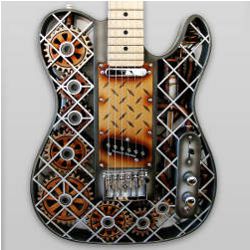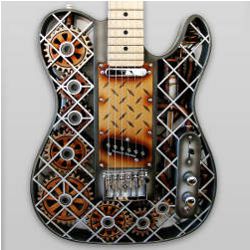
The future of manufacturing may seem far removed from a typical household. If Hod Lipson has his way, however, a machine that can fabricate just about anything will land in living rooms and offices within a few years.
Lipson, a professor of engineering at Cornell University, foresees a world brimming with 3D printers that spit out an array of things. Already, the devices have been used to fabricate coffee mugs, medical devices, food items, bicycles, furniture, musical instruments, and sailing vessels. “The technology promises to revolutionize many fields and fundamentally change our lives,” says Lipson, the co-author of Fabricated: The New World of 3D Printing (Wiley, 2013).
It is no small matter. 3D printers—which lay down plastics, metals, and almost any other material, adding layer upon layer until a design is completed—turn the traditional concept of whittling away at wood, metals, and other materials—”subtractive” manufacturing—upside down. In fact, advances in hardware, along with increasingly sophisticated software, have recently unleashed a wave of innovation that is now sweeping through research labs and into the workplace and home. “3D printing is evolving in many ways and at a very rapid pace,” states Simon Leigh, an affiliated research fellow in the School of Engineering at the University of Warwick in the U.K.
Like any emerging technology, 3D printing creates opportunities, but it also raises questions and some serious concerns, particularly revolving around the illicit use of printers to fabricate drugs, weapons, keys, counterfeit parts, and numerous other items. What makes 3D printing so powerful is an ability to use open source designs to rapidly and inexpensively print objects—thereby bypassing conventional distribution channels. This makes it possible to create a limited series or print run of an item. Moreover, 3D printers can fabricate designs that are difficult and too expensive to produce using conventional manufacturing methods; for example, an individual might fabricate a star-shaped cake, or a lamp that displays a complex 3D mathematical form.
Moving Beyond Paper
The origins of 3D printing extend back to the mid-1980s, when Carl Deckard and Joseph Beaman at the University of Texas at Austin invented a process called Selective Laser Sintering (SLS). The process fuses materials—metals, plastics, ceramics, and more—into a three-dimensional mass. In 1984, inventor Charles Hull introduced what is generally considered the first genuine 3D printer. It used stereolithography—also known as optical fabrication—to introduce the idea of rapid prototyping. By 1995, researchers at the Massachusetts Institute of Technology (MIT) had built a modified inkjet printer that could extrude a binding solution onto a bed of powder. The device spawned actual 3D printing companies.
The technology has continued to march forward; printheads on devices can now move both horizontally and vertically to create nearly unlimited design possibilities. They can fabricate multiple moving parts with a single movement, and even apply different materials to different parts of an object. This high level of flexibility allows designers to experiment with new ideas that would be cost-prohibitive using conventional manufacturing methods.
Today, commercial 3D printers are widely available at a cost of tens of thousands of dollars—while consumer versions hover just above $1,000. Designers and manufacturers are turning to these devices for rapid prototypes, models, and specialty manufacturing. These systems rely on a computer-aided design (CAD) file to tell the printer what to fabricate. In some cases it will be an entire item, and in others, it will be a product requiring some assembly that will be fabricated component by component. Depending on the complexity of the item, the production process can vary from minutes to hours.
At the University of Washington, for example, researchers have printed bow ties, a composting toilet, and a usable boat. So far, they have fabricated items from about 50 different materials, including glass, ceramics, metals, plastic, chocolate, and rice. “It is possible to print using virtually any material,” explains Mark Ganter, a professor of mechanical engineering at the University of Washington. In fact, 3D printing technology—technically referred to as “additive manufacturing”—is advancing rapidly. Some printers now support multiple materials—thus enabling far more sophisticated designs.
The ability to print actual devices using multi-depositional processes has caught Leigh’s attention. He and fellow researchers have developed a new material, nicknamed “carbomorph,” which lays down electronic tracks and sensors within a 3D structure. In fact, this process enables touch-sensitive areas that can be added to a basic electronic circuit board. The next step, he says, is to add cables and wires that would make the object a fully functional device, such as a television remote control, mobile phone, or a game controller.
Leigh says metals and plastics—the conventional materials used in 3D printing—are giving way to more sophisticated composites that allow far more advanced manufacturing methods, along with more sophisticated products. Lipson says that 3D software is maturing and a growing pool of designs is available. At the same time, machine learning is making it easier to predict how different materials will interact, and how they can be used together to create more advanced materials, shapes, and functions.
Cornell University has developed, among other things, toys, edible printed food items, and robotic insects using 3D printing technology. The latter devices—made of polyethylene film and weighing in at 3.89 grams—can hover on their own for 85 seconds. Lipson, who introduced an open source 3D printing initiative called Fab@Home in 1995 (it has emerged as a primary source for 3D printing designs), is continuing to push the technology forward. “Most things that are manufactured can be printed with 3D technology,” he says.
In fact, 3D printing could turn the physics of manufacturing upside down. “Fabricating a complex object is no more expensive or time-consuming than printing a simple object,” Lipson says. “This is a huge departure from the historical model of manufacturing—where more difficult designs require more skill, time, and labor.” He adds that 3D printers could further redefine manufacturing, if software compilers are available to transform a concept into a technical design (like a shelf bracket or a coffee mug); a person would simply state what he or she wants, and the computer would handle the process. This would eliminate the need for programming and engineering skills to create designs, he says.
Navigating a New Frontier
Major manufacturers are adopting 3D printing technology at a rapid clip. Airbus, Ford Motor Company, Adidas, Logitech and scores of other companies are turning to industrial 3D printing for rapid prototyping, as well as for the actual production of products. For instance, airplane manufacturer Airbus uses industrial 3D printing to produce certain cabin components.
Lower-cost 3D consumer printers are appearing in homes, allowing individuals to produce plates, drinking glasses, toys, lamps, jewelry, clothing accessories, and other items on demand. Individuals now share designs for 3D printing at sites such as Thingiverse and Fab@Home.
Many describe 3D printing as highly disruptive, because it could displace a large number of jobs by eliminating much of the distribution system and business infrastructure that exists today.
The technology is not without concerns, however. Many describe 3D printing as highly disruptive, because it could displace a large number of jobs by eliminating much of the distribution system and business infrastructure that exists today. A more immediate concern is that the technology makes it relatively easy to fabricate counterfeit products rapidly, and to manufacture illegal items such as weapons and drug paraphernalia. “It’s an issue that could make the controversy over illegal music downloads pale by comparison,” Lipson warns.
Meanwhile, researchers are continuing to push the envelope on 3D printing. Scientists have begun to experiment with printing artificial organs, and have successfully produced a liver, bone, cartilage, and blood vessels. Within a decade or two, it will likely be possible to print usable human tissue, including a heart, from cartridges of human cells. The appeal of 3D bio-printing is the array of tissue and organs that could be constructed using a single printer.
The University of Washington’s Ganter believes 3D printing ultimately will offer enormous benefits, including the ability to use common materials—dirt, salt and other widely available materials—to fabricate much-needed objects inexpensively in developing nations. 3D printers also could make it easier to provide relief at a disaster site by fabricating temporary housing and various necessities. Finally, the technology could alter the waste stream and provide substantial environmental benefits, he notes. “Imagine printing objects from recycled plastic and other materials rather than using wood and other raw materials,” Ganter says.
Make no mistake, 3D printing has come of age. As the underlying software becomes increasingly sophisticated and more-complex printer designs move into the mainstream, a new era of fabrication and manufacturing will emerge, one that offers lower barriers to entry and delivers a high level of customization. Concludes Lipson: “The revolution in 3D printing is already taking place. Within a decade, the average person will have a 3D printer in their house and at their business. The technology will become a core part of our lives.”
Further Reading
Campbell, T.A., Ivanova, O.S.
3D printing of multifunctional nanocomposites, Institute for Critical Technology and Applied Science (ICTAS), Virginia Tech; http://www.sciencedirect.com/science/article/pii/S1748013212001399
Willis, K., Brockmeyer, E., Hudson, S., Poupyrev, I.
Printed optics: 3D printing of embedded optical elements for interactive devices, Proceedings of the 25th annual ACM symposium on User interface software and technology, Pages 589-598, ISBN: 978-1-4503-1580-7; http://dl.acm.org/citation.cfm?id=2380190
Leigh, S.J., Bradley, R.J., Pursell, C.P., Billson, D.R., Hutchins, D.A.
A Simple, Low-Cost Conductive Composite Material for 3D Printing of Electronic Sensors, 2012, PLoS ONE 7(11): e49365. doi:10.1371/journal. pone.0049365; http://www.plosone.org/article/info%3Adoi%2F10.1371%2Fjournal.pone.0049365
Lipson, H., Kurman, M.
Fabricated: The New World of 3D Printing, John Wiley & Sons, 2013.
Figures
 Figure. The Steampunk 3D guitar, inspired by the classic Fender Telecaster, features a 3D printed body with moving gears and piston. The entire body of the instrument, including all its moving parts, is printed as a single component, with no further assembly required.
Figure. The Steampunk 3D guitar, inspired by the classic Fender Telecaster, features a 3D printed body with moving gears and piston. The entire body of the instrument, including all its moving parts, is printed as a single component, with no further assembly required.
 Figure. 3D printers work with a variety of materials and can produce life-like models from 3D scans.
Figure. 3D printers work with a variety of materials and can produce life-like models from 3D scans.




Join the Discussion (0)
Become a Member or Sign In to Post a Comment